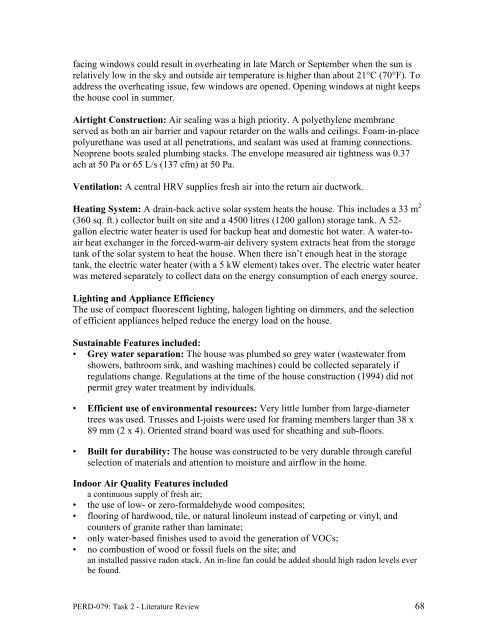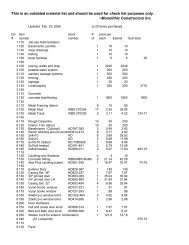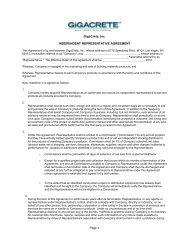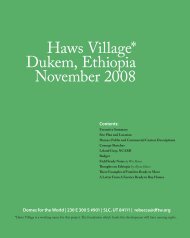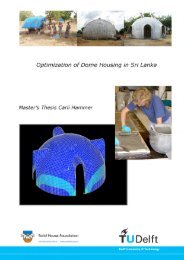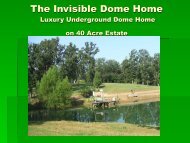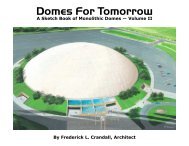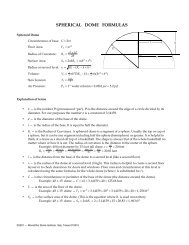Literature Review on Building Envelope, Heating and ... - Beeshive.org
Literature Review on Building Envelope, Heating and ... - Beeshive.org
Literature Review on Building Envelope, Heating and ... - Beeshive.org
Create successful ePaper yourself
Turn your PDF publications into a flip-book with our unique Google optimized e-Paper software.
facing windows could result in overheating in late March or September when the sun is<br />
relatively low in the sky <strong>and</strong> outside air temperature is higher than about 21°C (70°F). To<br />
address the overheating issue, few windows are opened. Opening windows at night keeps<br />
the house cool in summer.<br />
Airtight C<strong>on</strong>structi<strong>on</strong>: Air sealing was a high priority. A polyethylene membrane<br />
served as both an air barrier <strong>and</strong> vapour retarder <strong>on</strong> the walls <strong>and</strong> ceilings. Foam-in-place<br />
polyurethane was used at all penetrati<strong>on</strong>s, <strong>and</strong> sealant was used at framing c<strong>on</strong>necti<strong>on</strong>s.<br />
Neoprene boots sealed plumbing stacks. The envelope measured air tightness was 0.37<br />
ach at 50 Pa or 65 L/s (137 cfm) at 50 Pa.<br />
Ventilati<strong>on</strong>: A central HRV supplies fresh air into the return air ductwork.<br />
<strong>Heating</strong> System: A drain-back active solar system heats the house. This includes a 33 m 2<br />
(360 sq. ft.) collector built <strong>on</strong> site <strong>and</strong> a 4500 litres (1200 gall<strong>on</strong>) storage tank. A 52-<br />
gall<strong>on</strong> electric water heater is used for backup heat <strong>and</strong> domestic hot water. A water-toair<br />
heat exchanger in the forced-warm-air delivery system extracts heat from the storage<br />
tank of the solar system to heat the house. When there isn’t enough heat in the storage<br />
tank, the electric water heater (with a 5 kW element) takes over. The electric water heater<br />
was metered separately to collect data <strong>on</strong> the energy c<strong>on</strong>sumpti<strong>on</strong> of each energy source.<br />
Lighting <strong>and</strong> Appliance Efficiency<br />
The use of compact fluorescent lighting, halogen lighting <strong>on</strong> dimmers, <strong>and</strong> the selecti<strong>on</strong><br />
of efficient appliances helped reduce the energy load <strong>on</strong> the house.<br />
Sustainable Features included:<br />
• Grey water separati<strong>on</strong>: The house was plumbed so grey water (wastewater from<br />
showers, bathroom sink, <strong>and</strong> washing machines) could be collected separately if<br />
regulati<strong>on</strong>s change. Regulati<strong>on</strong>s at the time of the house c<strong>on</strong>structi<strong>on</strong> (1994) did not<br />
permit grey water treatment by individuals.<br />
• Efficient use of envir<strong>on</strong>mental resources: Very little lumber from large-diameter<br />
trees was used. Trusses <strong>and</strong> I-joists were used for framing members larger than 38 x<br />
89 mm (2 x 4). Oriented str<strong>and</strong> board was used for sheathing <strong>and</strong> sub-floors.<br />
• Built for durability: The house was c<strong>on</strong>structed to be very durable through careful<br />
selecti<strong>on</strong> of materials <strong>and</strong> attenti<strong>on</strong> to moisture <strong>and</strong> airflow in the home.<br />
Indoor Air Quality Features included<br />
a c<strong>on</strong>tinuous supply of fresh air;<br />
• the use of low- or zero-formaldehyde wood composites;<br />
• flooring of hardwood, tile, or natural linoleum instead of carpeting or vinyl, <strong>and</strong><br />
counters of granite rather than laminate;<br />
• <strong>on</strong>ly water-based finishes used to avoid the generati<strong>on</strong> of VOCs;<br />
• no combusti<strong>on</strong> of wood or fossil fuels <strong>on</strong> the site; <strong>and</strong><br />
an installed passive rad<strong>on</strong> stack. An in-line fan could be added should high rad<strong>on</strong> levels ever<br />
be found.<br />
PERD-079: Task 2 - <str<strong>on</strong>g>Literature</str<strong>on</strong>g> <str<strong>on</strong>g>Review</str<strong>on</strong>g> 68


